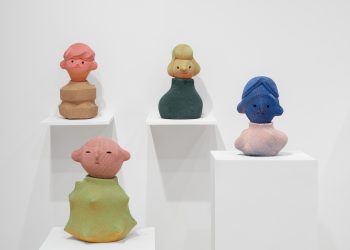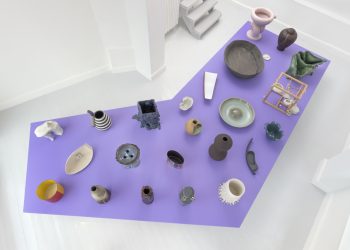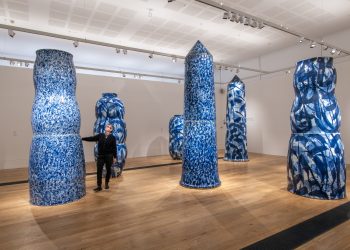















New White: Contemporary porcelain art is on view at Keramiekcentrum Tiendschuur, Tegelen
July 5, 2024 – January 5, 2025
Porcelain, or the so-called ‘white gold’, was imported from Asia into Europe in the sixteenth century. During the eighteenth century, there were also some locations in Europe where porcelain was successfully created. For a long time, products made of porcelain have remained highly exclusive. Today, you can find porcelain everywhere. Everyday items like washbasins, toilet bowls, dinnerware, prostheses, and even knives and machine parts are made of this hard white material. The exhibition in Keramiekcentrum Tiendschuur displays contemporary porcelain art created by eleven leading ceramists from all over Europe. This exhibition partly runs parallel with the exhibition ‘Porseleinkoorts’ at the Nationaal Keramiek Museum Princessehof in Leeuwarden.
It is telling that after all these centuries the use of porcelain is still so popular among ceramists. Although their usages are very diverse, for many they feel challenged by the tough material that seems so fragile at the same time. In this exhibition, works are shown that are slab-built, mould-casted, thrown on the wheel, or made by 3D printers. The sources of inspiration are very diverse: sometimes, it is the material itself with its offering of endless technical possibilities; other times, it is the work process or the manifestation of nature and its natural forms that give spark to the shaping of the clay. There are works where the object loudly speaks for itself and there are the ones where their meaning transcends their material forms. Whereas at Nationaal Keramiek Museum Princessehof, the focus lies on eighteenth-century European porcelain, at Keramiekcentrum Tiendschuur, the works of contemporary European porcelain artists find their stage.
The following artists take part in the exhibition:
Henk Wolvers (The Netherlands) solely works with porcelain. He loves the unruliness of the material and is constantly searching to stretch its boundaries. In his objects, he seeks transparency, a kind of ethereal structuring, and a certain lightness, which are also characteristic of his work.
Willy van Bussel (The Netherlands) throws his porcelain bowls on the wheel and makes them so thin-walled that light shines right through. They seem so fragile yet are made of such hard material.
Guy van Leemput (Belgium) has been making wafer-thin pots for some years. His objects don’t weigh much at all and one looks right through them. The decorations on the outside of the bowls shine right through and are visible from the inside too. The decorative patterns are made by filigree work, perforation, plaiting or pressing out.
Anima Roos (Belgium) throws her objects on the wheel. She makes light objects and wavy vessels with or without patterns. Her point of departure is always a familiar form that she gradually deforms and adapts by using additional materials. It ultimately creates a sense of estrangement.
Antje Scharfe’s (Germany) works recall seventeenth-century still-life art and staterooms full of porcelain but also remind us of well-filled crockery cupboards. By using the trompe-l’oeil paint technique she plays with the space and our minds.
Wied en Diederik Heyning (The Netherlands) are a creative couple who have been working together for a long time. As in a dialogue, Diederik Heyning creates objects in porcelain and Wied Heyning reacts to these forms by painting them. Contrast and opposition are important elements in their work. The objects appear fragile, light, and airy, while the material is hard and strong.
Kiho Kang (South Korea/Germany) finds it essential to show the manual work process in his work. The visible marks of his fingers in the clay are time, effort and patience materialised. Kiho Kang finds inspiration in architecture, daily life objects, and his childhood memories in South Korea.
Tineke van Gils (The Netherlands) connects traditional craftmanship with a permanent hunger to experiment with clay on the wheel. She finds it important that her work, after firing, breathe the same kind of energy and vitality that she put in during the making of them.
Michael Fargo (Israel/Germany) looks for the boundaries between imitation and interpretation in her ceramics. She combines the aesthetics of the natural form with the possibilities of modern times.
Gráinne Watts (Ireland) finds inspiration in her work in the diverse forms and colour combinations of nature. Organic geometry, patterns and markings of time embellish her pots and make out an integral part of her created forms.
Heide Nonnenmacher (Germany) also finds inspiration in nature and creates works that are inspired on coral. Her choice of inspiration is well-considered and came about as she was seeking to show the fragility of our planet. By showing these natural forms that, in actuality, are suffering from the effects of climate change, she uses her ability as an artist to generate attention for this topic.
What the future looks like for the art of porcelain is hard to foresee, but the fact is that porcelain clay has been an inspiration for many in the past centuries and it is probably here to stay.
Artists: Willy van Bussel (NL); Michal Fargo (IL/DE); Tineke van Gils (NL); Wied en Diederik Heyning (NL); Kiho Kang (KR/DE); Guy van Leemput (BE); Heide Nonnenmacher (DE); Anima Roos (BE); Antje Scharfe (DE); Gráinne Watts (IE); Henk Wolvers (NL)
Curator: Miranda Timmers
Contact
info@tiendschuur.net
Keramiekcentrum Tiendschuur Tegelen
Kasteellaan 8
5932 AG Tegelen
the Netherlands
Photos courtesy of the gallery


















